In 1851 the British Empire invited the world to London for a showcase of the achievements of the industrial age. While such exhibitions had been staged as far back as 1791, this ‘Great Exhibition of the Works of Industry of All Nations’ was the biggest and most universal.
A vast exhibition hall, substantially made of glass and dubbed the ‘Crystal Palace’, was erected in Hyde Park. The Great Exhibition of 1851 ran from the first of May to 15 October and was an astonishing success, attended by six million visitors.
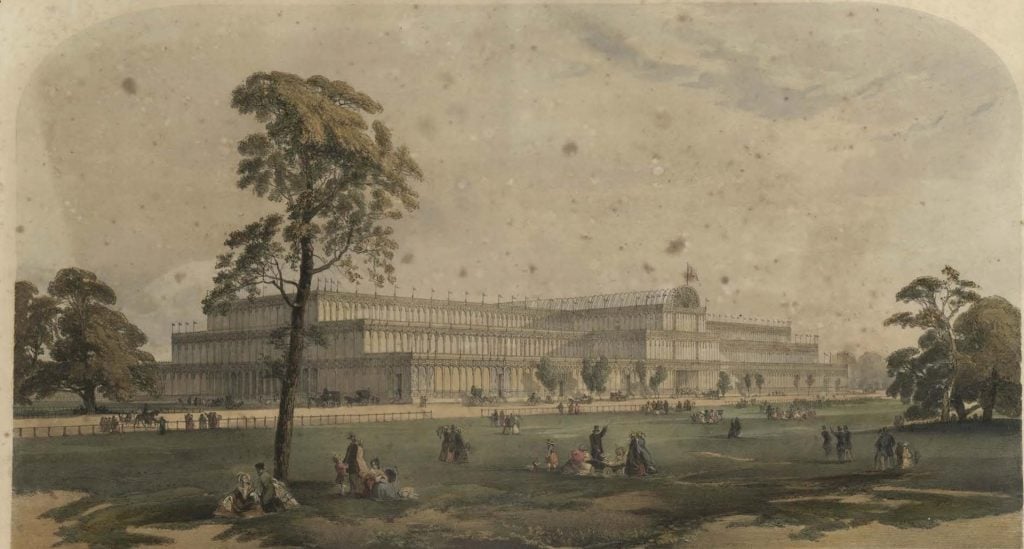
Crystal Palace, from Dickinson’s comprehensive pictures of The Great Exhibition of 1851, vol 3
On July 1 in that same year, on the other side of the world, the Port Phillip District of New South Wales became the colony of Victoria. Almost immediately news of gold strikes started to circulate, precipitating a gold rush. The population tripled in four years with a flood of new arrivals seeking their fortune. 1
The new colony flourished, awash with the affluence of gold, commerce and agriculture.
The ambitious denizens of Melbourne had taken note of London’s Great Exhibition. Commissioners, headed by Judge Redmond Barry, were appointed to organise Victorian contributions to the next great World Fair, the Paris Exposition Universelle (Universal Exhibition) to be held in 1855.
There was hope that:
In time, a great Victorian exhibition may be accomplished, and, though we might not at last be able to construct a Palace of Glass, a roomy building of zinc or corrugated iron would serve every practical purpose. (Argus, 2 May 1854)
The commissioners appear to have taken the newspaper’s advice, although with rather greater ambition. On the 21st of June they announced that a Melbourne exhibition would be held in October as a prelude to Paris. Not for the commissioners a building of ‘corrugated iron’. Plans soon were underway for Melbourne’s own ‘Crystal Palace’.
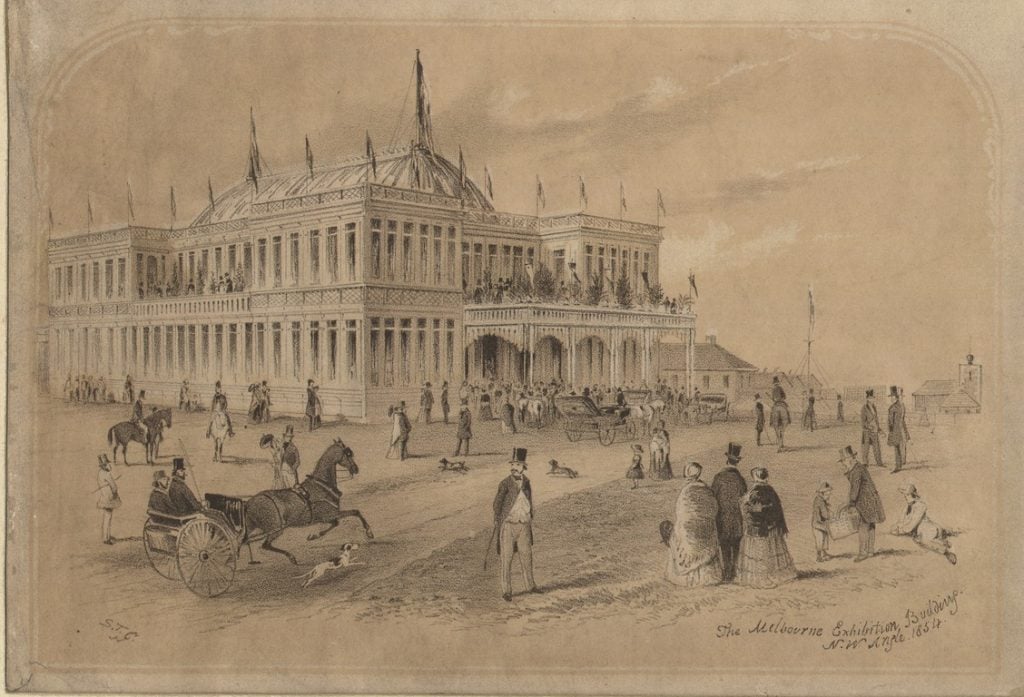
The Melbourne Exhibition Buildings, NW angle, 1854. Lithograph by S.T.Gill; H2295
While considerably smaller than the London structure, construction of Melbourne’s first Exhibition Building, on the corner of William and Little Lonsdale Streets, commenced in August, 1854. This predominantly glass building was intended as a temporary structure and was assembled with much haste in the shadows of the exhibition opening.
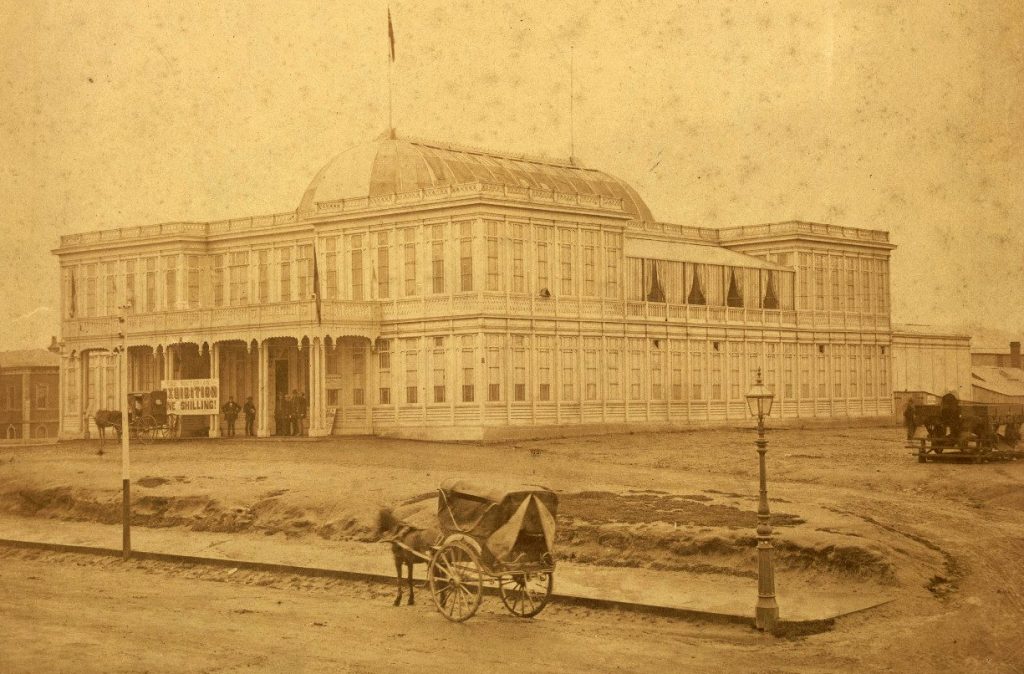
First Exhibition Building, 1861; H130
Originally expected to cost £7,500 (Mount Alexander Mail, 29 September 1854), the final bill was three times that. 2
The Melbourne Exhibition opened on 17 October and was marked by a public holiday.3 The new Age newspaper celebrated by printing their first edition in the Exhibition Hall (Age, 17 October 1854). The exhibition ran for 30 days, closing on 12 December, having been attended by 40,000 citizens.
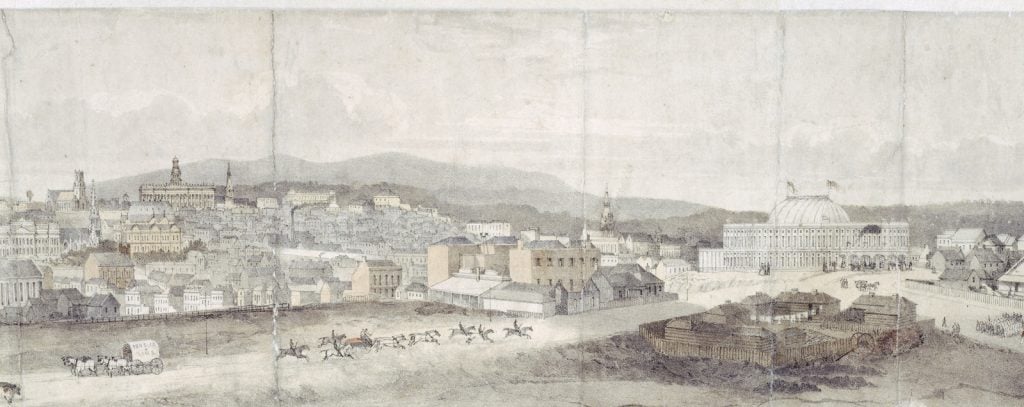
The Exhibition Building, dominating Melbourne’s skyline. Detail from Melbourne 1854. Lithograph by George Rowe; H605b


Old Exhibition Building, where Mint now stands. Engraving by James Redaway; H13613 (left)
First Exhibition Building William Street Melbourne; H2017.102/1 (right)
In 1861, from 1 October to 29 November, a second exhibition was held and was seen as being significantly more impressive, understandably given the vast increase in population and industry over the subsequent 7 years. This time it was a preliminary to the 1862 London Exhibition and it drew 67,000 visitors.
The Exhibition Hall had many and varied uses including mayoral balls, banquets, dog shows, land sales and political meetings. The Melbourne Philharmonic Society performed there until 1866 (Argus, 26 December 1966). You can see some of the events held at the Exhibition Hall below.
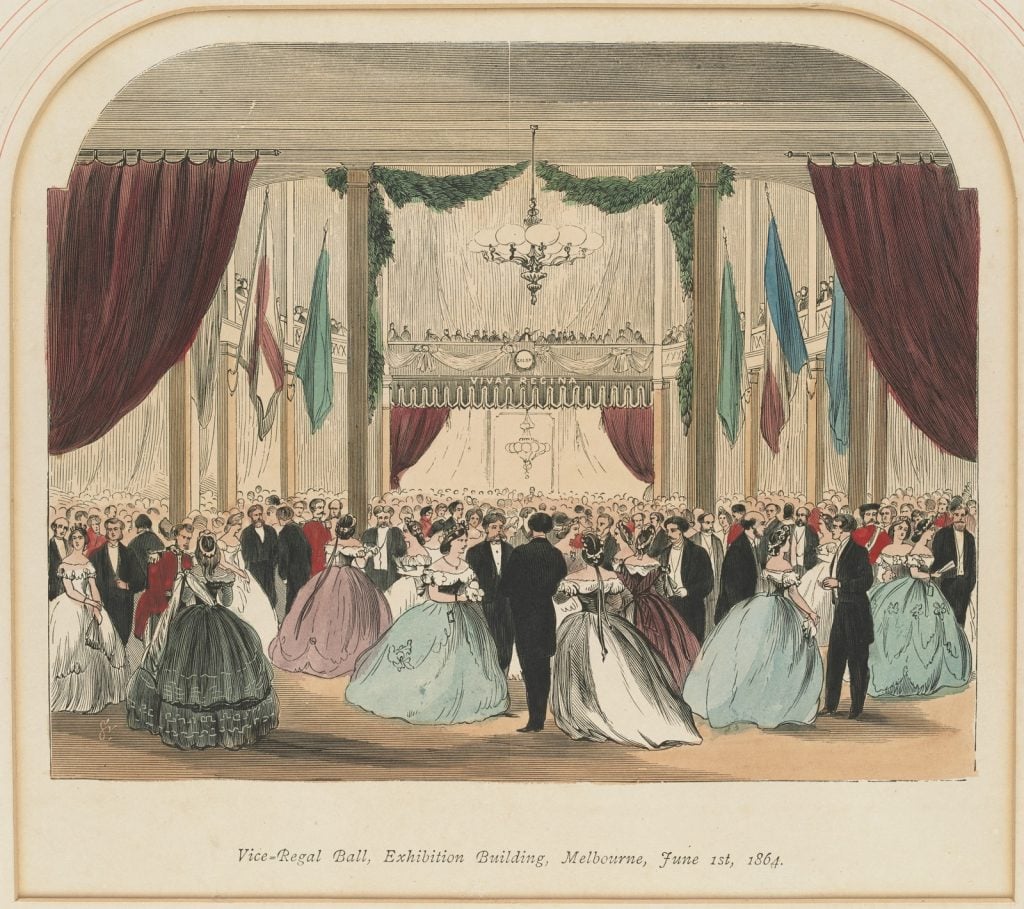
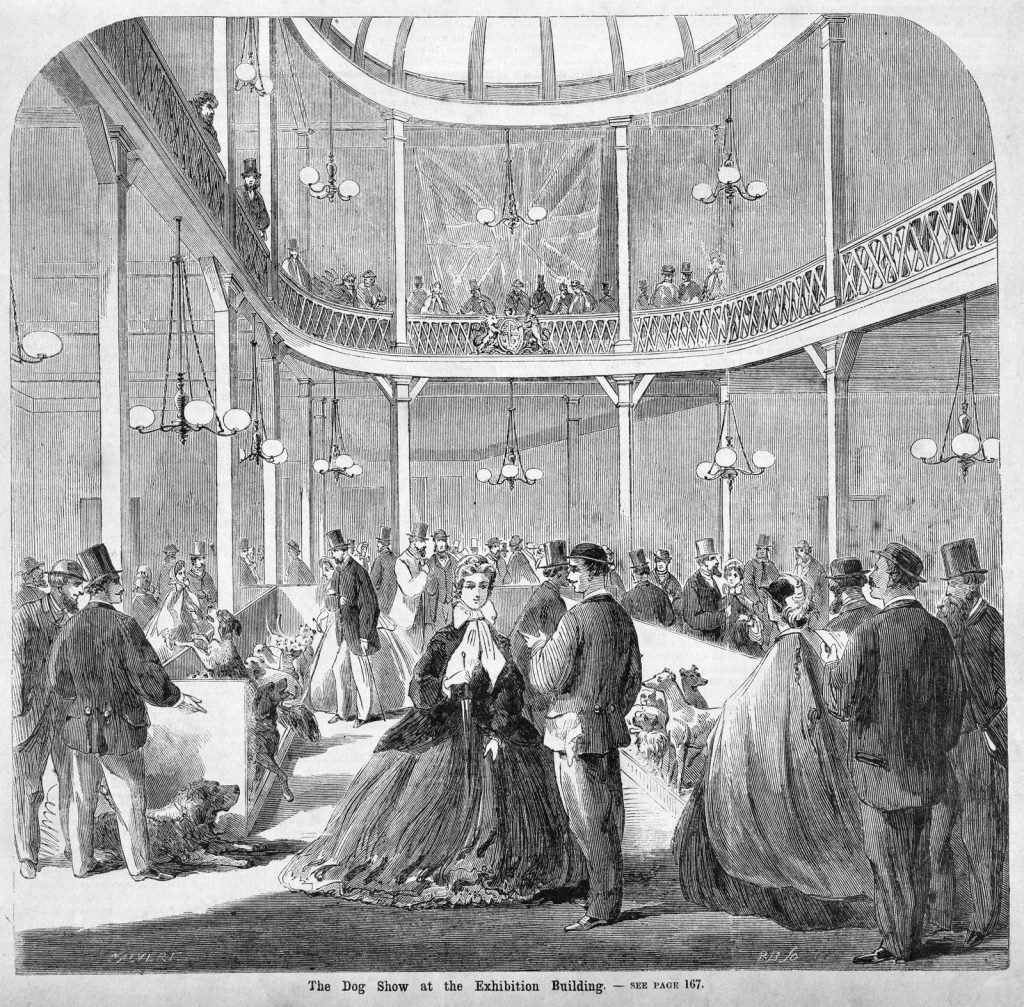
Vice-Regal Ball, Exhibition Building, Melbourne, June 1st 1864. Wood engraving by Samuel Calvert; H15519 (left)
The Dog Show at the Exhibition Building, 25 November 1865. Wood engraving by Robert Bruce; IMP25/11/65/161 (right)
The building’s initial grandeur faded. Built hastily, and always considered a temporary events space, the years had not been kind. In 1866 a new exhibition hall was built behind Melbourne Public Library’s Queens Hall, on the location where the grand domed La Trobe Reading Room now stands. The Great Hall was built for the Intercolonial Exhibition which ran from 24 October 1866 until 23 February 1867.
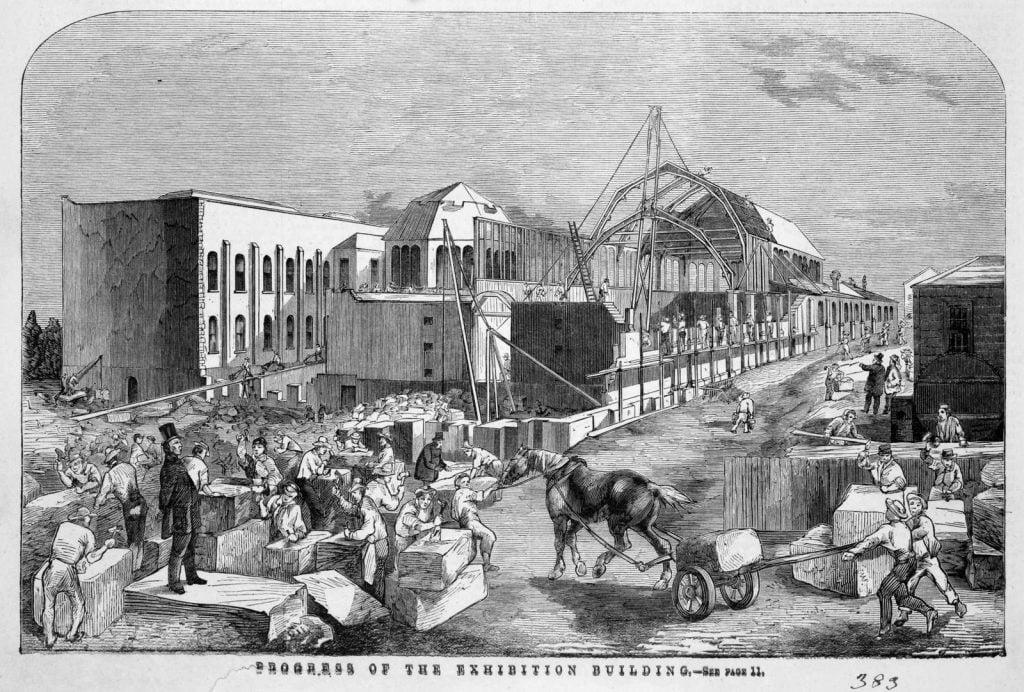
Progress of the exhibition building, 27 August 1866; IAN27/08/66/8. The second exhibition hall, known as the Great Hall, was built at the State Library where the domed La Trobe Reading Room now stands

The Intercolonial Exhibition: interior of the rotunda, 27 November 1866. Wood engraving by S.T Gill; IMP27/11/66/372
Immediately prior to the opening of the 1866 Intercolonial Exhibition, the new Exhibition Building hosted the Mayor’s Fancy Dress Ball. The 1866 ball was particularly famous for the spectacular costume worn by Matilda Butters, who attended the event dressed as ‘The Press’. (Age, 21 September 1866)
Perhaps the last hurrah for grand events at the first Exhibition Building was the ‘Return’ Mayoral Ball held on 4 October and again attended by Mrs Butters in her Press dress but this time including a ‘Second Edition’ tassel. (Australasian, 6 October 1866)
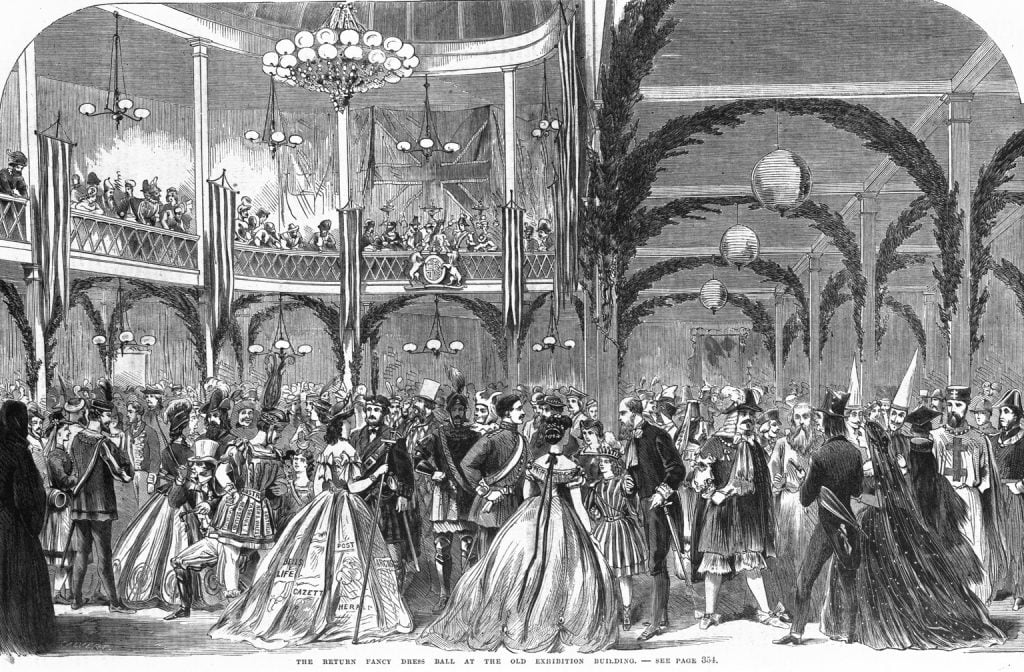
Mrs Butters and ‘The Press’ dress at The Return Fancy Dress Ball at the Old Exhibition Building, 27 October 1866; MP27/10/66/357

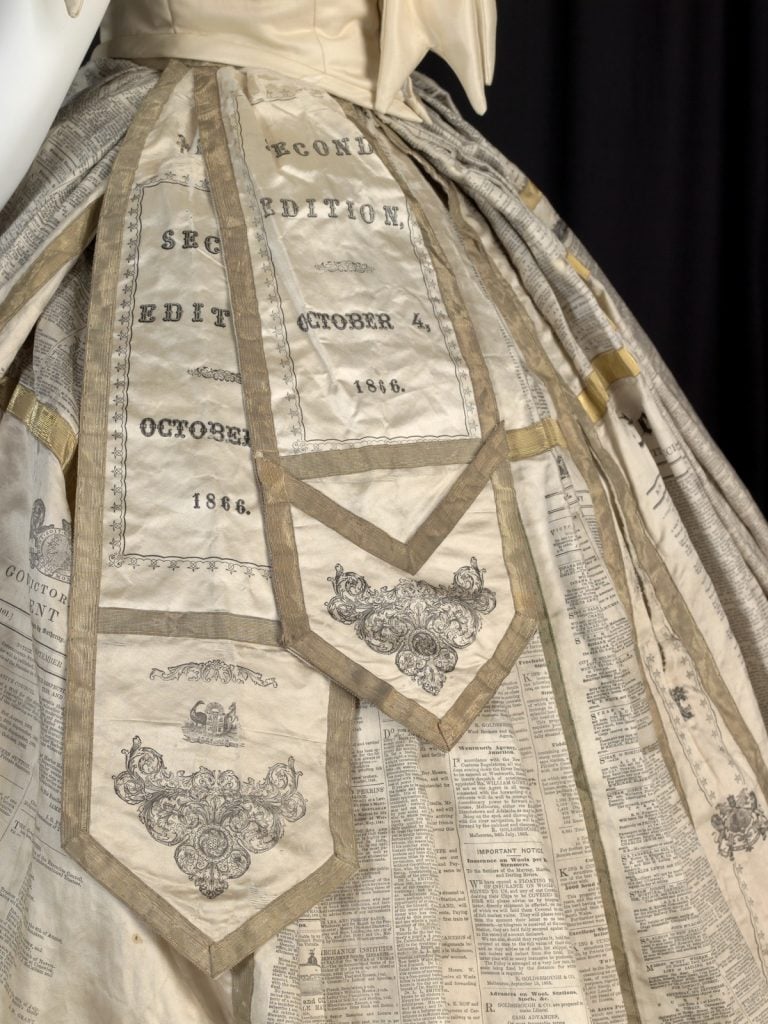
The Press (fancy dress skirt and part of sash). Created by dressmaker, Mrs William Dobbs; H141541. Note the ‘Second Edition’ tassel added for the Return Fancy Dress Ball at the first Exhibition Building
The first Exhibition Building continued to fall into disrepair. One letter writer asked:
Cannot the government devote a few pounds to putting the Old Exhibition-building in order by having the broken glass replaced with new (sic). At present the appearance of the building is positively hideous, and a stranger riding by would scarcely credit the fact that it is a public building. (Herald, 16 July 1868)
Finally the building was sold in 1868 and dismantled to make way for the new Royal Mint building. The carriage annexe was used as a gymnasium and staved off demolition for another year, finally being removed in 1869. (Herald, 3 November 1869)
The grand new Royal Exhibition Building was completed in time to host the Melbourne International Exhibition of 1880-1881 taking over from the Great Hall at the Library which was dismantled in 1908 to make way for the domed La Trobe Reading Room.
The Royal Exhibition Building has lasted rather longer than its predecessors. It is still currently used for exhibitions and is the only Melbourne building included on the UNESCO World Heritage list.
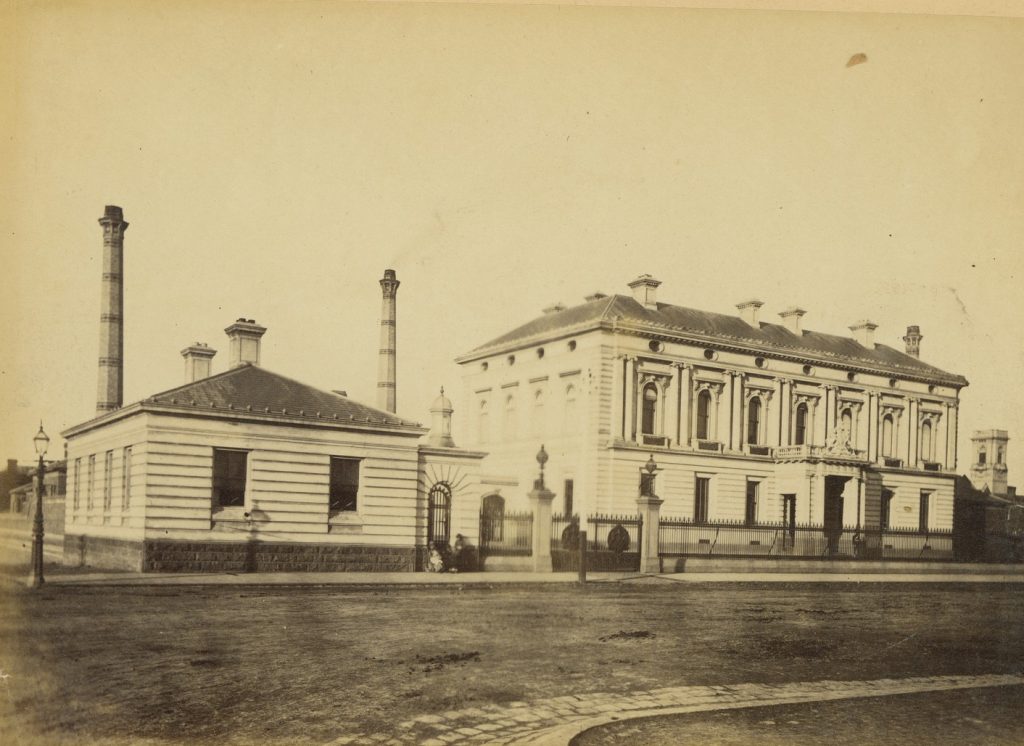

The Victorian Mint. Photo by Daniel McDonald; H2001.20/335. The mint was built on the former site of Melbourne’s first Exhibition Building (left)
The Royal Exhibition Building. Photo by J. W Lindt; H2001.60/38 (right)
19th century intercolonial and international exhibitions
For further details on each exhibition see our Research Guide: Intercolonial and international exhibitions
First Exhibition Building
Cnr Little Lonsdale and William Streets (built 1854, demolished 1868-69)
- 1854 Melbourne Exhibition in preparation for the Paris Exposition Universelle 1855
- 1861 Victorian Exhibition in preparation for the London International Exhibition 1862
Second Exhibition Building
Behind (Ian Potter) Queen’s Hall, State Library Victoria (built 1866, Great Hall demolished 1899, Rotunda demolished 1908)
- 1866-67 Intercolonial Exhibition of Australasia in preparation for the Paris Exposition Universelle 1867
- 1872-73 Victorian Exhibition in preparation for the London International Exhibition 1873
- 1875 Victorian Intercolonial Exhibition in preparation for the Philadelphia Centennial Exhibition 1876
Royal Exhibition Building
Carlton Gardens (built 1879-80)
- 1880-81 Melbourne International Exhibition
- 1888-89 Centennial International Exhibition
- A limited range of Victorian exhibits (mainly wine) were featured in the Paris Exposition Universelle 1889
You may also like these blogs
References
- Australian Bureau of Statistics 3105.0.65.001 Australian Historical Population Statistics, 2019 viewed 30 Nov 2021,<https://www.abs.gov.au/statistics/people/population/historical-population/latest-release#data-download>
- Centennial International Exhibition, 1890, Official record of the Centennial International Exhibition, Melbourne, 1888-1889, Sands & McDougall, Melbourne
- Victorian Government Gazette, no 93, 13 October 1854, p 2257, viewed 30 November 2021 <http://www.austlii.edu.au/au/other/vic_gazette/1854/93/1854_2257.pdf>

